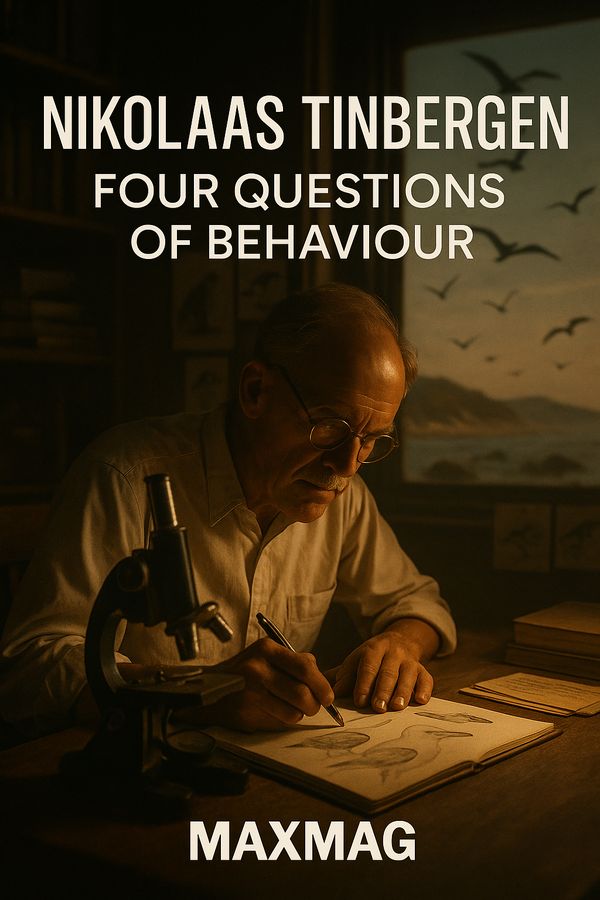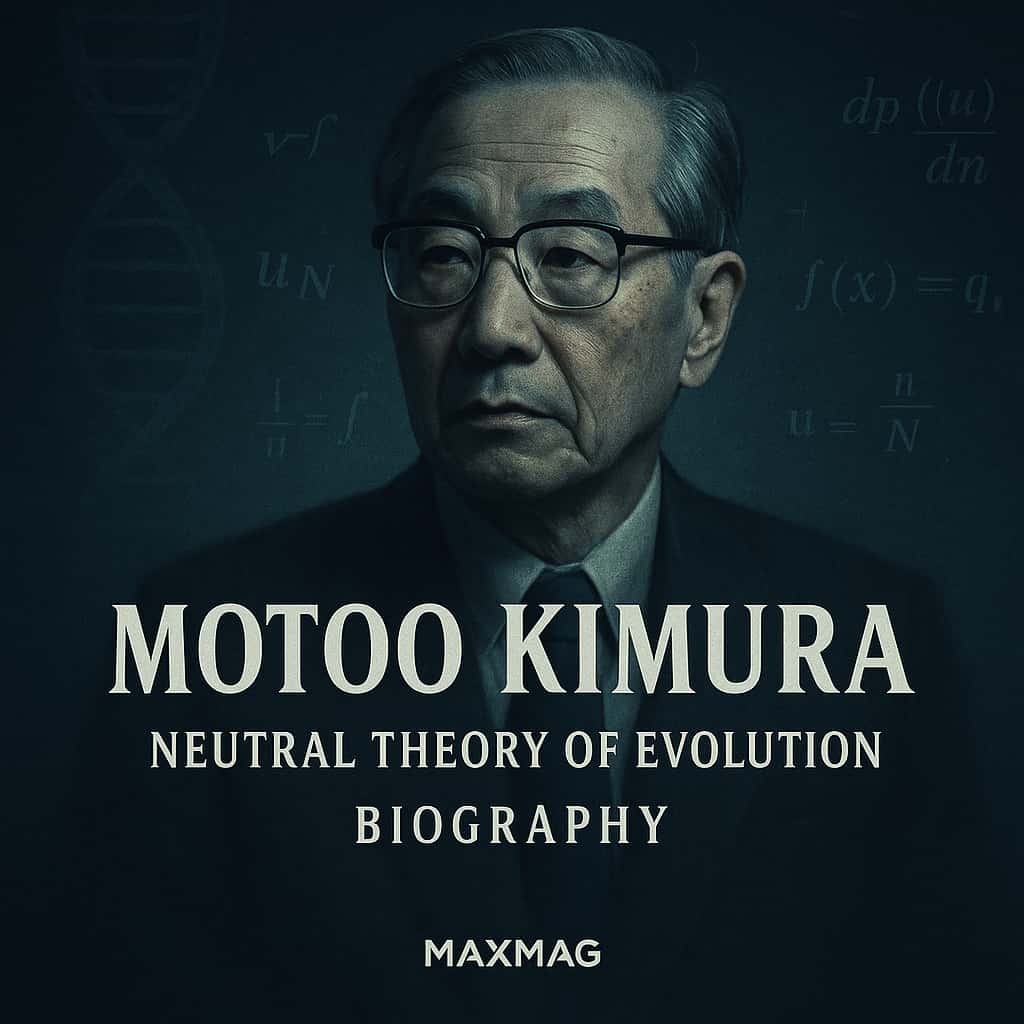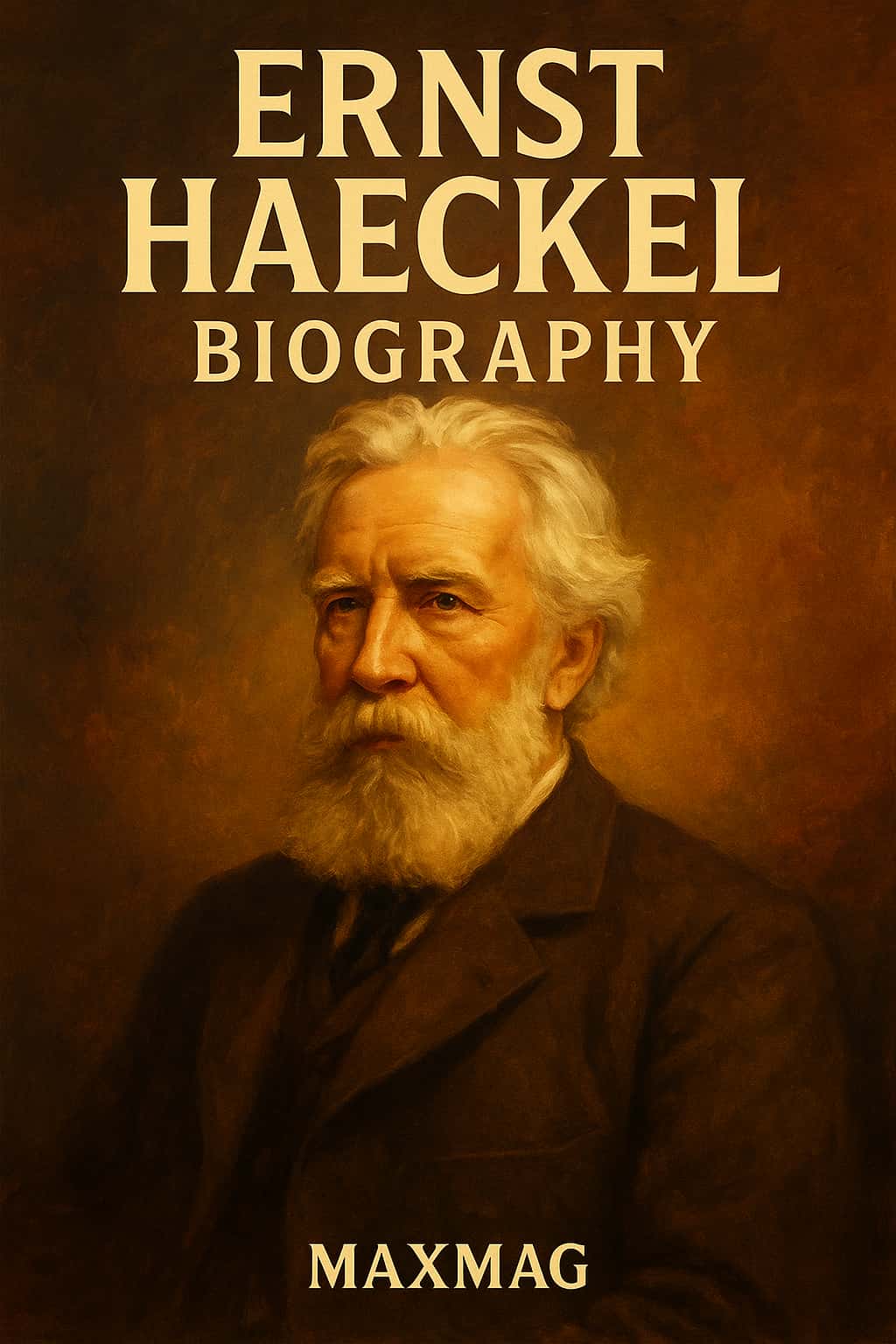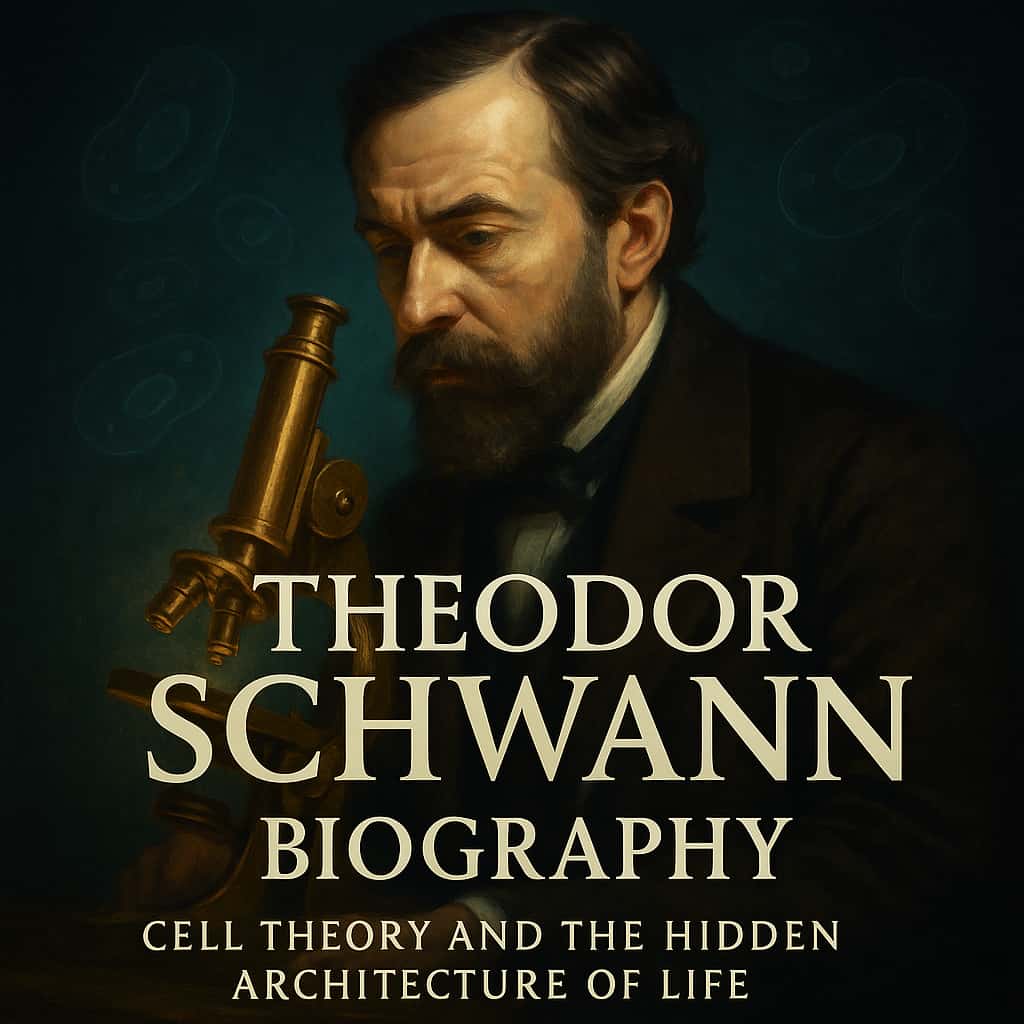
The Barbara McClintock biography reads almost like a detective story, unfolding not in city streets but in rows of corn that shimmered in the New York summer heat. Long before “genomics” became a buzzword, McClintock was quietly watching maize kernels change colour from one generation to the next and asking why. Her answer – that pieces of DNA could move around the genome – sounded outrageous in the 1940s, when genes were supposed to be fixed like beads on a string. For decades, many colleagues simply didn’t believe her.
Yet this same Barbara McClintock biography ends with a Nobel Prize, a flood of honours and a place in the history of genetics alongside Mendel and Watson and Crick. McClintock was a cytogeneticist, a specialist who studied chromosomes under the microscope, and a genetics pioneer whose ideas about “jumping genes” changed how we think about evolution, disease and even how our own cells respond to stress. Understanding her life means understanding not just a single discovery, but the messy, human way in which science advances – through doubt, stubbornness and flashes of insight that may take decades to be recognised.
At a glance:
- Who: Barbara McClintock, American cytogeneticist and genetics pioneer.
- Era: 20th-century science, from the 1920s to the early age of molecular biology.
- Known for: Discovering mobile genetic elements, the “jumping genes” that helped launch modern genetics.
- Why she matters: Her work underpins today’s understanding of genome plasticity, cancer genetics and how organisms adapt under stress.
Early Life and Education of Barbara McClintock
From Hartford to Brooklyn: a solitary child in a noisy world
Barbara McClintock was born in Hartford, Connecticut, in 1902, the third of four children in a family that was comfortable but far from wealthy. Her father was a homeopathic doctor; her mother, artistic but anxious about money and social expectations. When finances became tight, young Barbara was sent to live with relatives in Brooklyn – a move that left her feeling both displaced and oddly independent. Later in life she would describe her greatest strength as a “capacity to be alone”, a phrase that echoes through every serious Barbara McClintock biography and helps explain her willingness to follow evidence even when it isolated her.
At Erasmus Hall High School in Brooklyn she found refuge in books and in the school laboratory. She was not the sort of girl her era encouraged: she preferred microscopes to dances, debate to small talk, and she asked questions that made teachers pause. Those teenage years did something important for the future genetics pioneer. They taught her that it was possible to stand slightly apart from the crowd and still hold her ground – a lesson she would draw on when her scientific ideas met resistance.
Cornell years that shaped the Barbara McClintock biography
Despite her mother’s fear that university would make her “unmarriageable”, McClintock enrolled in Cornell University’s College of Agriculture in 1919. At first she drifted between subjects, dabbling in music and campus politics, but a genetics course in 1921 changed everything. Taught by plant breeder C. B. Hutchison, it introduced the strange logic of Mendel’s peas and chromosome behaviour. McClintock was captivated. When Hutchison later phoned to invite her into an advanced graduate course, she took it as a sign that genetics would be her life’s work.
Cornell at the time was a hotbed for plant breeding and what was becoming known as cytogenetics – the study of chromosomes. McClintock earned a BSc, then an MA and PhD, all officially in botany but focused on maize chromosomes. She helped build a small, intense research group that spent long days staring down microscopes at stained maize cells, mapping out which chromosomes carried which traits. In these cramped, busy rooms, the outlines of the later Barbara McClintock biography already existed: meticulous observation, technical innovation and an ability to see patterns other people missed.
Barbara McClintock biography and the Birth of Her Big Ideas
Visualising maize chromosomes in an era before DNA
In the late 1920s and early 1930s, genetics was still largely a black box. Scientists knew that genes lived on chromosomes, but not what genes were made of or how they did their work. McClintock’s early research tackled that ignorance with simple but brilliant tools. Using improved staining techniques, she produced clear images of maize chromosomes, showing for the first time the distinct shapes of the plant’s ten chromosomes and linking them to traits such as kernel colour and starchiness.
This might sound technical, but it was crucial for the history of genetics. If you think of a genome as a book, McClintock was one of the first to sketch a reasonably accurate table of contents for maize. These foundational studies, often skimmed over in a quick Barbara McClintock biography, provided the map that made later discoveries about chromosome behaviour possible.
Crossing-over and the first big turning point in the Barbara McClintock biography
Working with fellow researcher Harriet Creighton, McClintock showed that the physical exchange of chromosome segments during meiosis – a process called crossing-over – matched the way traits were shuffled in offspring. The pair could literally see under the microscope when pieces of chromosome had swapped places, and then confirm that the resulting maize plants displayed new combinations of traits. It was elegant, visual proof that genes really did move during reproduction, long before anyone could sequence DNA.
This work made McClintock a respected figure in 1930s genetics. She won prestigious fellowships, spent time at the University of Missouri and Caltech, and was already being described by colleagues as a leading figure in 20th-century science. For a time, the Barbara McClintock biography looked like a story of steady ascent in a male-dominated field, driven by technical skill and sharp intuition.
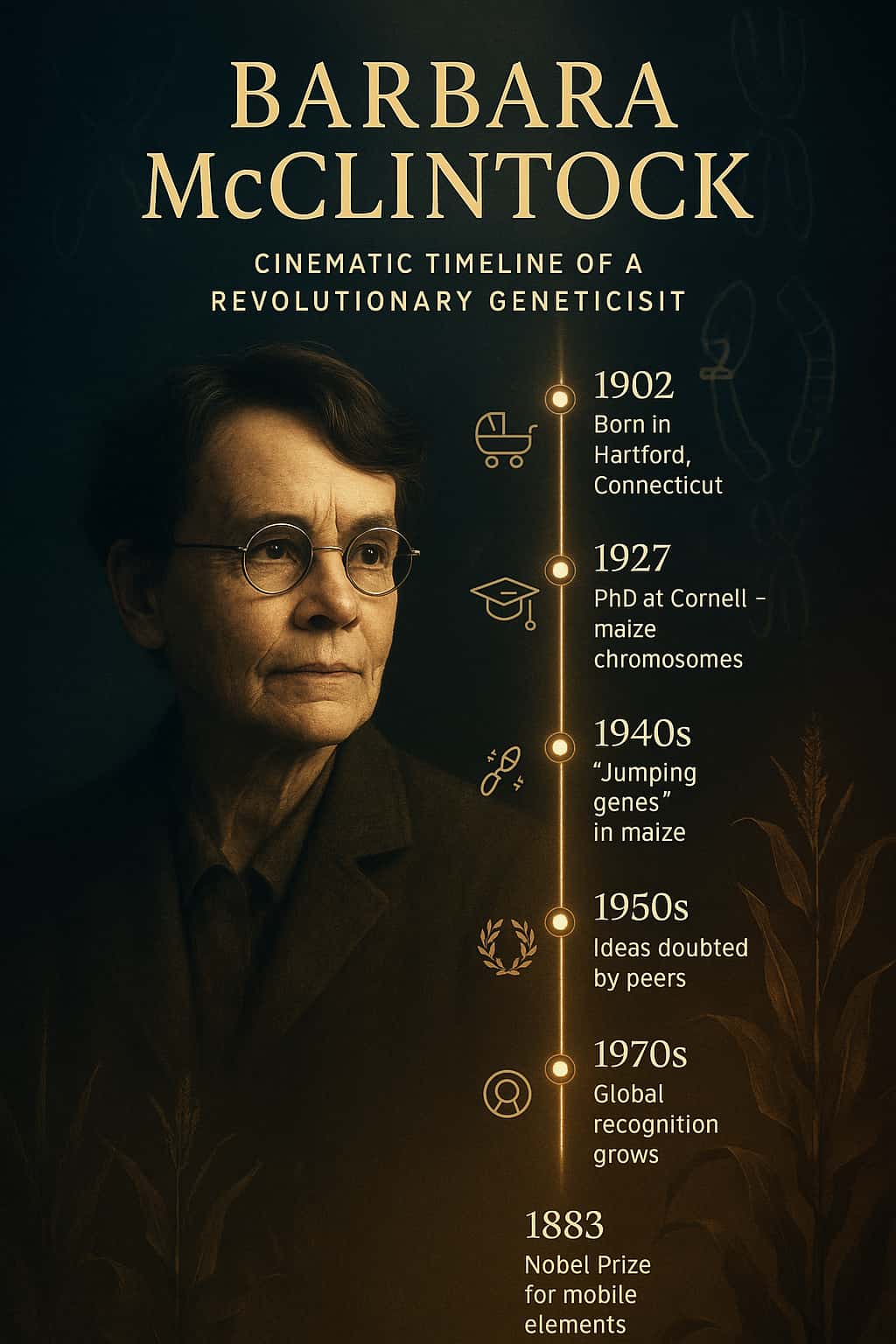
Key Works and Major Contributions of Barbara McClintock
The breakage–fusion–bridge cycle: watching chromosomes shatter and heal
One of McClintock’s most striking early contributions was her description of the “breakage–fusion–bridge” cycle. Exposing maize to X-rays, she watched as chromosome ends broke, fused together and then tore apart again in subsequent cell divisions. The result was a chaotic dance of shattered chromosomes, sometimes producing plants with variegated leaves or kernels. From these seemingly messy patterns, McClintock inferred deep rules about how chromosomes maintain stability, including the importance of telomeres, the protective caps at chromosome ends.
Today, when we talk about cancer cells with unstable genomes or telomere shortening in ageing, we are drawing on concepts that trace back to this work. A serious Barbara McClintock biography cannot treat her simply as the discoverer of jumping genes; she also mapped out the ways chromosomes cope with damage and stress, decades before molecular tools existed to confirm her ideas.
Discovery of “jumping genes” in maize
In the 1940s, at Cold Spring Harbor Laboratory on Long Island, McClintock turned her attention to maize kernels with mottled, patchy colours. Most geneticists assumed such odd patterns were just random noise. She suspected something more structured. By following the behaviour of certain chromosome regions over many generations, she identified elements she called Dissociation (Ds) and Activator (Ac). These segments, she realised, could move from one place in the genome to another. When they landed near a pigment gene, they could switch it on or off, producing kernels speckled like miniature mosaics.
The insight was radical: the genome was not a static text, but a living manuscript with paragraphs that could be cut, pasted and rearranged. In modern terms, McClintock had discovered transposable elements, or transposons – “jumping genes”. Her work anticipated by decades the later flood of research showing that such mobile elements shape everything from antibiotic resistance in bacteria to the architecture of human genomes. Many geneticists now see her as a central figure in the history of genomics, even if that label did not exist during most of her career.
Understanding gene regulation before it was fashionable
McClintock did not stop at showing that genes could move. She argued that controlling elements like Ac and Ds might help cells regulate which genes are active under stress – a primitive form of gene regulation. In an era when many scientists still thought of genes as fixed instruction units, this idea sounded mystical or speculative. Yet when François Jacob and Jacques Monod later published their famous work on bacterial gene regulation in the 1960s, the conceptual parallels with McClintock’s maize work were hard to ignore. In a quiet but pointed article, she compared her findings with theirs, gently suggesting that plant chromosomes had been telling a similar story all along.
Seen from today’s vantage point, this aspect of the Barbara McClintock biography is as striking as the discovery of jumping genes themselves. She was not just finding new genetic elements; she was proposing a dynamic view of the genome that modern biologists now take for granted.
Methods, Collaborations and Working Style
A “feeling for the organism” as a scientific method
If you ask colleagues what set McClintock apart as a scientist, they rarely begin with equipment or equations. Instead, they talk about her intense, almost meditative attention to her plants. She spent countless hours in maize fields and in the greenhouse, memorising entire lineages of plants, noticing subtle differences in kernel pattern or tassel shape. Biographer Evelyn Fox Keller later captured this as a “feeling for the organism” – a way of knowing that combined rigorous data collection with an empathetic sense of the plant as a living system.
To non-scientists, this can sound like mysticism. Critics sometimes caricatured her approach as unscientific intuition. But in practice, it meant that when most people would see “just another patchy ear of corn”, McClintock saw a precise, testable pattern in need of explanation. This distinctive working style is one of the quiet threads that run through every thoughtful Barbara McClintock biography and helps explain how she spotted phenomena that others overlooked.
Collaborators, mentors and the wider genetics community
McClintock’s story is often told as that of a lone genius, but she moved through rich networks of scientists. At Cornell she worked alongside Rollins Emerson, Marcus Rhoades and Harriet Creighton; at Missouri she collaborated with Lewis Stadler, who introduced her to X-ray mutagenesis; at Cold Spring Harbor she rubbed shoulders with some of the most influential figures in mid-century genetics. She served as president of the Genetics Society of America in 1945, and in 1944 became only the third woman elected to the US National Academy of Sciences – hardly the career of an isolated outsider.
At the same time, the Barbara McClintock biography is marked by periods when she chose to step back from the mainstream. When she felt that her controlling-element work was being misread or dismissed, she stopped publishing detailed accounts, continuing instead to refine her ideas in notebooks and lectures. It was a bold move that preserved her intellectual independence, but also slowed the wider acceptance of her discoveries.

Controversies, Criticism and Misconceptions
Why the Barbara McClintock biography was once a cautionary tale
By the 1950s, some colleagues regarded McClintock as a brilliant but increasingly marginal figure. Her talks on controlling elements were met with polite confusion; a few listeners openly doubted her data. In an era when molecular biology was shifting attention towards bacteria and phages, her maize work could look old-fashioned. For young geneticists building careers on clear, linear models of gene action, the mobile, context-dependent genome McClintock described felt unnervingly complex.
Later, feminist historians of science would argue that gender bias shaped these reactions. Here was a woman without a traditional professorship, working largely alone at a research station, asking colleagues to discard some of their most comfortable assumptions. It was easy to recast the Barbara McClintock biography as a warning: stray too far from the mainstream and you risk being ignored. The reality, as so often, was messier. Her data were sound, but the language and conceptual framework available at the time made it hard for others to grasp what she had seen.
Myths of mysticism and the reality of rigorous work
Another recurring misconception portrays McClintock as a kind of scientific mystic, guided more by intuition than by experiment. This stereotype feeds on her own use of words like “feeling” and “listening” to describe her relationship with plants. Yet detailed studies of her notebooks and published papers show a painstaking experimentalist: she counted kernels, tracked pedigrees, recorded environmental conditions and ran repeated crosses to test each hypothesis.
Recent historians have argued that this part of the Barbara McClintock biography reveals more about our discomfort with non-mechanical language than about her methods. She dared to describe the natural world in terms that acknowledged its complexity and our emotional engagement with it, without abandoning statistical rigour. In doing so, she challenged not just scientific ideas but the culture of science itself.
Impact on Genetics and on Wider Society
From cornfields to cancer labs: a broad scientific legacy
When McClintock received the Nobel Prize in Physiology or Medicine in 1983, it was officially “for her discovery of mobile genetic elements”. The citation captured only part of her impact. Transposons now sit at the centre of many fields: they shape how we understand genome evolution, they help explain how bacteria acquire antibiotic resistance, and they are used as tools to disrupt genes experimentally in plants and animals. In human medicine, mobile elements are implicated in some cancers and genetic disorders, making her work unexpectedly relevant to modern oncology.
Outside the lab, the Barbara McClintock biography has become a touchstone for discussions about how radical ideas are received. Her story is taught in history-of-science courses, highlighted in women-in-science initiatives and cited in debates about how funding systems treat unconventional research. She shows that scientific revolutions do not always arrive with fanfare; sometimes they begin in silence, in a maize field where one person is willing to pay very close attention.
A symbol for women in science and for intellectual independence
McClintock never married and had no children. She lived in modest rooms near Cold Spring Harbor, dividing her time between the fields, the greenhouse and her small office. To some, this has made her a symbol of sacrifice: a woman who gave up a “normal life” for science. But she resisted that narrative. She insisted that her life had been rich in friendship, intellectual excitement and quiet joy. What mattered, she said, was the freedom to follow a question wherever it led.
For many younger scientists, especially women, the Barbara McClintock biography offers a different kind of role model. It shows that a research career need not follow a conventional academic path and that stepping away from fashionable topics does not mean stepping away from important questions. Her life has been used in outreach materials by museums and educational institutions as an example of persistence, creativity and the long arc of recognition.
Personal Beliefs, Character and Private Life
Stubbornness, humour and a preference for solitude
Those who knew McClintock describe a woman who could be intensely private yet disarmingly funny in small groups. She disliked fuss and ceremony, preferring to talk about plants rather than prizes. When journalists came calling after the Nobel announcement, she kept interviews short and steered conversations back to maize genetics. Friends recall that she could be stubborn to the point of exasperation when she believed a result was correct, but also quick to laugh at her own missteps.
This mix of independence and warmth runs through the more intimate details of the Barbara McClintock biography. She loved walking in the fields alone at dusk, listening to crickets and thinking about chromosomes. She read widely outside science, from poetry to philosophy, and was wary of any ideology – scientific or political – that claimed to have all the answers.
Attitudes to recognition and fame
When the flood of honours arrived in the 1970s and 1980s – the National Medal of Science, the MacArthur “genius” grant, the Nobel Prize – McClintock accepted them with a kind of amused detachment. She was pleased that her work was finally understood, but she worried that too much focus on awards might distort the story. In later interviews she returned again and again to the same point: the crucial events in the Barbara McClintock biography were not the ceremonies, but the long days of puzzling over data that did not fit existing theories.
Her attitude offers a quiet rebuke to celebrity culture in science. For McClintock, the real reward was the moment when the data and the organism “told you something you had not expected”, and you were awake enough to hear it.

Later Years and Final Chapter of Barbara McClintock
Cold Spring Harbor as home and intellectual refuge
McClintock settled permanently at Cold Spring Harbor Laboratory in the 1940s and never really left. Even after her official retirement in 1967, she continued to work as a Distinguished Service Member, advising younger scientists and tending to her maize plots. The lab named a building after her, but she seemed more comfortable in the greenhouse than in the grand lecture hall.
In the 1960s and 1970s, as molecular biology caught up with her predictions, visiting researchers began to seek out the woman whose once-puzzling maize results now made perfect sense in the light of DNA sequencing and gene regulation. For the first time, the Barbara McClintock biography was being told not as an odd footnote to genetics history but as a central narrative about how genomes work.
Nobel recognition and the end of the story
When the Nobel Committee finally honoured her in 1983, McClintock was 81 years old. The prize citation explicitly compared her to Gregor Mendel, another solitary figure whose work was misunderstood for decades. She became the first woman to receive an unshared Nobel Prize in Physiology or Medicine. Shortly afterwards, journalists and historians rushed to capture her story, producing books, documentaries and long-form articles that helped spread the Barbara McClintock biography beyond specialist circles.
McClintock died in 1992 in Huntington, New York, aged 90. Obituaries in major newspapers portrayed her as a “gene research pioneer” whose patience had finally been rewarded. One New York Times obituary captured the tone: understated, respectful and slightly astonished that someone so influential could have spent so many years working in relative obscurity.
The Lasting Legacy of the Barbara McClintock biography
Genome plasticity and modern genetics
Today, no serious genetics textbook omits transposable elements. They are woven into explanations of genome evolution, development and disease. Researchers use them as tools to knock out genes in model organisms, to trace cell lineages and to build mutagenesis screens in crops. Cold Spring Harbor Laboratory’s own archival collections on McClintock are now a resource for historians and geneticists alike, documenting how a once-controversial idea became a cornerstone of modern science.
The Barbara McClintock biography has also become a case study in how science self-corrects, but not always quickly. Her story is used in discussions about peer review, about how funding bodies value high-risk research and about the importance of diversity in scientific communities. If more people had shared her background, her working style or simply her willingness to take maize seriously as a model, might her ideas have been recognised sooner?
Why the Barbara McClintock biography still matters
For readers today, the value of the Barbara McClintock biography lies in more than its inspirational arc. It reminds us that organisms are not just convenient experimental systems but complex partners in discovery. It shows that paying close attention to details others overlook can unlock entirely new ways of thinking. And it suggests that real originality may require a tolerance for being misunderstood for a long time.
In an age of big data and short funding cycles, her life is a reminder that some questions demand slow, patient, deeply contextual work. To understand jumping genes, McClintock needed not just statistics or sequencing machines – she needed a lifetime with maize. In that sense, understanding the Barbara McClintock biography helps us understand something bigger about science itself: that insight often arises where rigorous method meets a stubborn, almost personal curiosity about how living things manage to be so endlessly inventive.
Frequently Asked Questions about Barbara McClintock biography
Q1: Who was Barbara McClintock and why is she important in genetics?
Q2: What makes the Barbara McClintock biography different from other scientist stories?
Q3: What exactly are “jumping genes” and how did McClintock find them?
Q4: Did Barbara McClintock work alone for most of her career?
Q5: How did gender bias influence Barbara McClintock’s career?
Q6: What can young scientists learn from the Barbara McClintock biography today?

